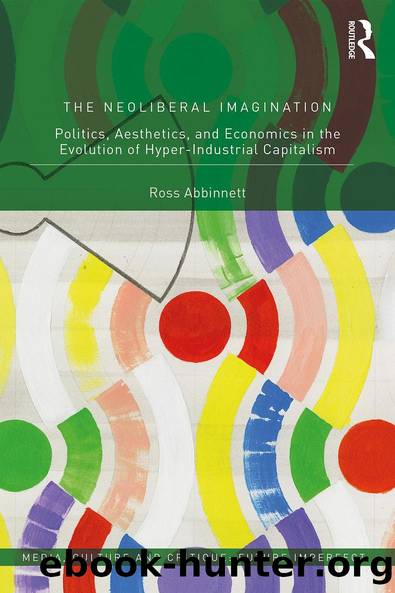The Neoliberal Imagination by Ross Abbinnett

Author:Ross Abbinnett [Abbinnett, Ross]
Language: eng
Format: epub
ISBN: 9780367186913
Barnesnoble:
Publisher: Taylor & Francis
Published: 2020-10-30T00:00:00+00:00
Marxism, culture, and nostalgia
Let us talk, for a moment, about ludicrous things. The word itself comes from the Latin ludicrum, which means a stage play, a contrived event that deliberately apes and exaggerates reality in an attempt to amuse the audience. What I have said above about the importance of the 1980s popular culture in the re-formation of liberal ideology, and particularly the aesthetic element of the New Romanic movement, is itself somewhat ludicrous. It is an exaggeration, a hyperbolic device, that requires considerable qualification if we are to understand why its reimagination of work, satisfaction, and desire was such an important moment in the genealogy of neoliberalism. Fredric Jameson, one of the most sophisticated neo-Marxist critics of postmodernism, also talks of ludicrous things. In his estimation, the concept of a âpostmodern cultureâ is ludicrous, primarily because it involves the idea that we have entered a new social era (an idea we first encountered with the âpost-industrial societyâ theses of Touraine and Bell) in which âcultureâ has attained a radical independence from the processes of capitalization. The postmodernist claim is that the expanding panoply of aesthetic forms offered by new media technologies is such that it constantly outplays the less agile process of capitalization. And so postmodern culture is characterized by a spontaneity that has spread throughout the public sphere: production and consumption are now much more reflexively oriented activities that are no longer determined purely by the metrics of utility and commodification. As a neo-Adornian, Jameson maintains that this putative movement of culture towards the spontaneous promotion of aesthetic self-creativity is, in the final analysis, an intensification of the relationship between the commodity form and the culture industry. As such, his position is that the ludic element of âpostmodern cultureâ â its promotion of self-invention in every sphere of life, its demand for flexible social attachment, its determination of aesthetic âstyleâ as the defining characteristic of individual âbeingâ â is simply âthe reflex and concomitant of yet another systemic modification of capitalism itselfâ (Jameson, 1995: xii). In order to understand the dynamics of the aesthetic hyper-individualism that is at the core of the neoliberal worldview, therefore, we have to recognize: (1) that new media technologies and the virtual sphere they have created do not constitute the emergence of a post-capitalist, or postmodern, form of society and (2) that we must carefully elucidate the way in which the relationship between capitalism, culture, and individualism has developed into a global-technological system of exploitative production and consumption (Jameson, 1995: 340â356).
According to Jameson, âpostmodernism theoryâ is ludicrous primarily because of its abandonment of the essential connection between culture, capitalism, and technology that is the crux of Adornoâs critical theory. The question of who the proponents of this dangerous tendency are is never fully addressed by Jamesonâs work, although it seems fair to assume that they comprise the usual suspects of French poststructuralism (Lyotard, Derrida, and Baudrillard), plus the coterie of âreadersâ in the United Kingdom and the United States who translated, interpreted, and disseminated their work.
Download
This site does not store any files on its server. We only index and link to content provided by other sites. Please contact the content providers to delete copyright contents if any and email us, we'll remove relevant links or contents immediately.
Cecilia; Or, Memoirs of an Heiress — Volume 1 by Fanny Burney(32363)
Cecilia; Or, Memoirs of an Heiress — Volume 3 by Fanny Burney(31738)
Cecilia; Or, Memoirs of an Heiress — Volume 2 by Fanny Burney(31706)
The Great Music City by Andrea Baker(31082)
We're Going to Need More Wine by Gabrielle Union(18897)
All the Missing Girls by Megan Miranda(15349)
Pimp by Iceberg Slim(14196)
Bombshells: Glamour Girls of a Lifetime by Sullivan Steve(13923)
Talking to Strangers by Malcolm Gladwell(13123)
Fifty Shades Freed by E L James(13114)
Norse Mythology by Gaiman Neil(13111)
For the Love of Europe by Rick Steves(12183)
Crazy Rich Asians by Kevin Kwan(9115)
Mindhunter: Inside the FBI's Elite Serial Crime Unit by John E. Douglas & Mark Olshaker(9094)
The Lost Art of Listening by Michael P. Nichols(7353)
Enlightenment Now: The Case for Reason, Science, Humanism, and Progress by Steven Pinker(7078)
The Four Agreements by Don Miguel Ruiz(6532)
Bad Blood by John Carreyrou(6468)
Weapons of Math Destruction by Cathy O'Neil(6077)
